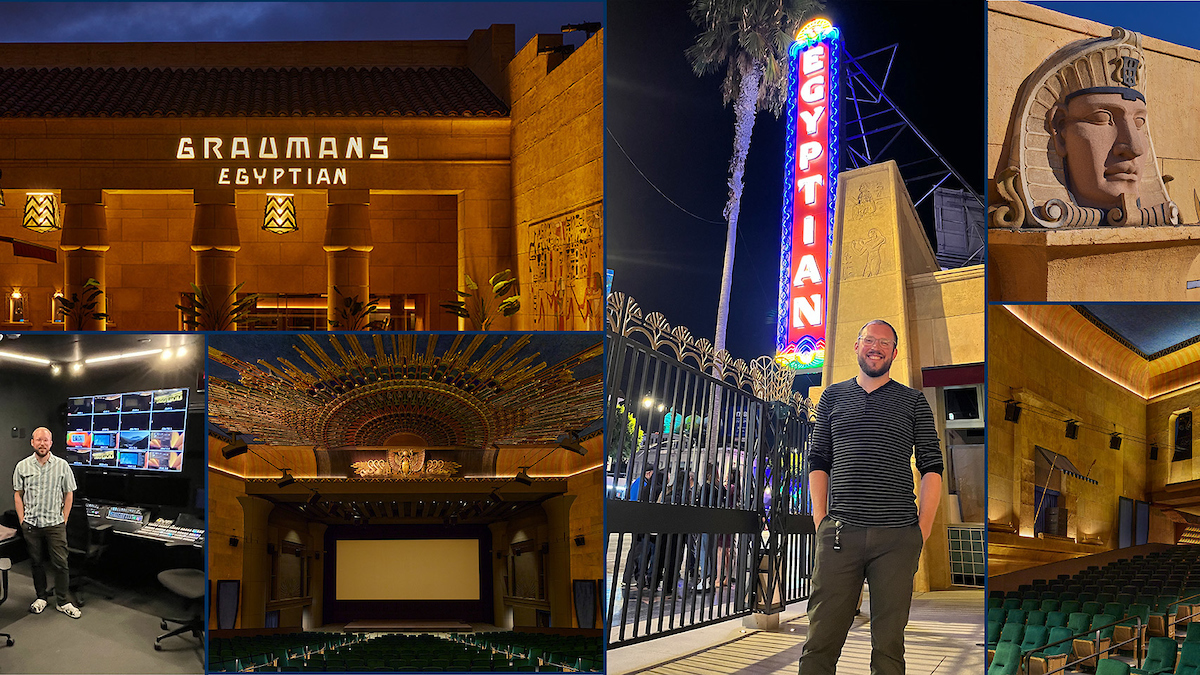CSUMB alumnus helps Netflix upgrade a legendary Los Angeles theater

CSUMB alumnus Evan Norbom helped renovate the recently reopened historic Egyptian Theater.
January 17, 2024
By Mark Muckenfuss
When the Egyptian Theater in Los Angeles reopened Nov. 9, theatergoers found themselves immersed not only in the aura of the century-old venue’s history and decor but also in the latest state-of-the-art technologies for both traditional and digital film and sound.
This latter aspect is thanks to California State University, Monterey Bay alumnus Evan Norbom, who oversaw the revamping of the existing theater projectors as well as the installation of new digital projectors and an 80-plus speaker array that produces Dolby Atmos sound. Those changes were part of a three-year, $70 million renovation of the theater.
Norbom, 35, a 2010 graduate of CSUMB’s cinematic arts program, was the lead designer for audio and video systems, and project manager for upgrading one of Hollywood’s last two iconic golden-age theaters – the other being the TCL Chinese Theater. Both the Chinese and the Egyptian were Graumann’s theaters for most of their histories. Netflix purchased the Egyptian in 2020.
“The Egyptian was where the first red carpet premiere was in 1922, for ‘Robin Hood,’” Norbom said, referring to the silent-era film starring Douglas Fairbanks. “That’s really where the showmanship and the glitz and the glamor started.”
Other premieres over the years included such films as “Ben Hur,” “My Fair Lady” and “Return of the Jedi.” Hollywood’s elite strode through the columns of the theater entrance as adoring fans looked on.
The weight of that history was a bit daunting, Norbom said.
“There aren’t too many places like this in the country,” he said, “let alone the world.”
Just as daunting were the technical hurdles.
Because the Egyptian is a recognized historic building, Norbom said, “there were restrictions on what we could do as far as construction. The parts that were there from 1922 needed to be preserved. We weren’t allowed to attach speakers to the wall.”
Instead, Norbom and his team of approximately 30 people hung the array of speakers from high-tension cables that run front-to-back across the theater. He also oversaw the installation of acoustic covering along the back wall of the theater to improve the sound quality. He noted that the theater was constructed in an age when films had no sound. An orchestra would play music to accompany what appeared on screen.
Even trickier than the sound system, he said, was making sure the existing film projectors would function properly so that old films could be shown in their original formats. Many parts were needed that are no longer produced.
“We had to incorporate some old audio processing hardware,” he said. “You can’t just buy it from Dolby. We had to restore what we could and find other used parts from the industry.”
He said he was fortunate to find some people steeped in the old technologies who became invaluable members of his crew.
“I couldn’t have done it without help and support from so many different areas,” Norbom said, referring not only to the technicians under his direction but also those involved in other aspects of the renovation. “This was definitely a team effort.”
Before joining Netflix, Norbom worked in various capacities in video and sound production in Los Angeles, Monterey and San Francisco. He said CSUMB prepared him well for working in the field.
“The big thing that really attracted me in wanting to go to CSUMB was the hands-on learning,” he said. “It was that that inspired me to take the path I’ve taken.”
He said he maintains contact with Chris Carpenter, a media production specialist with CSUMB’s Cinematic Arts and Technology Department, as well as several colleagues from his days as an Otter.
“I’ve not only been hired by alumni, but I’ve hired alumni,” he said. “I obviously support the university and would like the program to continue to expand.”
His experience at CSUMB, he said, helped open doors that led him to Netflix and the renovation of the Egyptian.
“I feel very fortunate to have had the opportunity I’ve had,” he said. “And this is really special.”